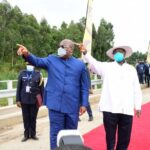By Edgar Tabaro
The aspirations of the Congalais are aptly captured in their national anthem “La Congolais” whose first stanza goes: “Arise, Congolese, United by fate, United in the struggle for independence, let us hold up our heads, so long bowed, and now, for good, let us keep moving boldly ahead, in peace. Oh, ardent people”.
The DRC has a long proud and not so proud history, Bas Kongo an ancient Kingdom in the far west at the Atlantic Ocean exchanged Ambassadors and were trade partners with Portugal in the 16 Century with a thriving civilization. In the precolonial period the eastern area (the Congo Forest areas) was an integral link in trade with the East African coast (Pwani), encompassing the Miombo woodlands, the plains of Eastern Kenya, the Interlacustrine region and the Sudan Savanah. This precolonial era, is probably the best epoch in the history of the land mass called Democratic Republic of Congo.
In 1885 The Congo Free State, a private estate of King Leopold was birthed where he proceeded to exploit it and execute a genocide that claimed 10 million lives. It turned out the biggest embarrassment of the 19th Century in world history. The immediate post-independence period ushered in instability arising from unstable central authority following the assassination of the legend Patrice Lumumba and attempts at secession of Katanga Province led by Moise Tsombe and its resulting Mulele rebellion aligned to the Lumumba orientation thinking that persist to date nostalgically lately by a charismatic and successful businessman Moise Katumbi owner of the TP Mazembe FC a brand name in African soccer.
There followed a brief period of stability (1967-77) under Mobutu Sese Seko Kuku Ngbendu Wa Za Banga who earlier as Chief of Staff of the Army through a close friend and CIA Director George Bush (later Vice President and President) had been hosted by Kennedy at the oval office and given special treatment to attend an elite military academy with a jet at his disposal for travel. As President, he was a regular visitor to the oval office, being hosted twice in 1970 alone under President Nixon. His closeness to the western powers gave him leeway to mismanage the country following a 10 year period of prosperity brought to the end following a coup attempt and wars in 1977 and 1978 in Shaba province. Mobutu retreated to country side Gbadolite Palace (famed for its opulence, in 1990 alone, ten thousand bottles of champagne was consumed there!) from where he ruled by remote control.
The country fell into a dysfunctional state. The eastern part fell into total collapse of the state. Basic services, such as agricultural extension, roads, schools, hospitals are lacking, yet it’s the richest minerals area in the DRC.
Prof. Mwesigwa Baregu in his seminal article “The Clones of Mr. Kurtz:Violence, War and Plunder in the DRC” in the African Journal of Political Sci. situates the conflict in the DRC through the epochs with a surgical analysis of the vicious cycle of violence that has become the face of the DRC in the result that a peace keeping mission MUNUSCO with 2000 that has consumed over 20 billion USD, the largest and most costly peace keeping operation in the history of the UN and yet the violence continues and multiplies unabated (eastern DRC is home to 133 militia groups).
Herein lies the challenge, the agenda of UN and other multilateral agencies is premised on peace keeping (as opposed to “peace enforcement” a new notion espoused by President Museveni) as well conflict resolution as opposed to conflict transformation). The approach of these bodies to which African intelligentsia are sold or conscripted is anachronistic to the values, ethos and interests of the African peoples. To this I will return herein later.
The eastern DRC conflict is essentially a subtly grounded in economic interests. This runs counter to the dominant narrative and agenda set by protagonists in the conflict, be they African or European. The sold narrative, the conflict is ethnic. It is my submission, the conflict is primarily over natural resources, the ethnic sentiments being secondary. Broadly, there are pastoralists, cultivators and the extractive industry as well as the commercial plantations. The three groups often clash in competition to access to these resources.
Importantly among these economic groups are fights within, that politicians and warlords have exploited in the lenses of ethicity. Among the Banyamulenge pastoralists of South Kivu are 3 contesting groups, Gumino, Twirwaneho and another linked to politicians in Kinshasa Azarius Ruberwa, Masunzu and Nyamusaraba crafted along immigrant Banyamulenge from Rwanda and natives in Congolese speak antoilette. These are largely pastoralists and a pitted against the Bashir who are cultivators. The contestation between real and perceived immigrants is central to the conflict in so far as the Kivus are concerned (to which return later).
The activities of the actors in the DRC are placated upon special interests often at variance with one another in the result that these interests have worked to obstruct the peace efforts in the DRC. The ever present challenge that we face is that the real and perceived interests drive the strategies and actions of the major actors in regional conflict.
The strategies and tactics adopted by the various actors before, during and after the negotiation of various peace agreements have been largely shaped by the logic of these interests, albeit, within the limitations imposed by the interests of other actors. Thus, there are times when some actors have collaborated in pursuit of their mutual interests and other times when they have conflicted because either their interests clashed or they have failed to come to some mutually beneficial arrangements, which can accommodate their mutual interests.
The efforts are overly presumptious, to the extent that every party in conflict has a vested interest in peace building and the resulting pre-occupation with negotiating peace agreements may be highly misplaced if major actors have vested interests in other objects such as the mineral wealth, and political gerrymandering at pronvicial, national and regional levels. Imperialists (African, and international ones), plunderers, warlords, gunrunners, drug-barons and such other predatory actors, in particular, tend to thrive in chaos in a relatively anarchic environment.
In North Kivu are cultivators from the Rwandaphone (Kinyarwanda speaking) community who in the past sided with cultivators from the Bafurero, and Nande and other cultivator Communities. Together they formed the Mutuelle Mutuelle agricole des Virunga (MAGRIVI) association of agriculturalist of Virunga of North but has over time been hijacked by Rwandaphone politicians to increase their state in RCD-Goma a special purpose vehicle crafted by a neighbouring state as a political party to compete in national elections (in the last parliament, out of 15 MPs for North Kivu 11 were RCD-GOMA Rwandaphones besides the Governor) thereby causing rifts with the other communities.
Enter the CNDP of Gen. Lauren Nkunda and Gen. Bosco Ntaganda aka “Terminator” both indicted by the ICC with the later serving time for war crimes, and acts of genocide representing pastoralists. The M23 (M Vigt trois) an offshoot of the CNDP attempted to craft an alliance of both pastoral and cultivator Rwandaphones, however, clashes arising access to proceeds from the illicit minerals trade bankrolled by external forces have increasingly undermined its power. Thus, the militias (133 at the writing of this article) impose taxes, and export minerals to sustain their livelihoods. The militia leaders have turned out soldiers of fortune and the lower rank and file mercenaries for external forces.
Earlier attempts at Disarmament, Demobilization and Resettlement have typically followed the scripts written for post conflict reconstruction with its attendant “one size fits all” approach. This, is what essentially failed the CNDP March 23rd 2009 Agreement that made it a condition for mixage (natives of Kivu being deployed outside of the home areas to other regions) for integration. The experiment, was a dismal failure giving birth to the M23 rebel movement that continues to threaten the existence of the DRC through an agenda of secession (locally called balkanization) of the Kivus with the support of expansionist forces in the region bent on establishing viceroy states.
Katanga province has picked the same sentiment. The DDR experiment failed principally because it only addressed the western approached tailored in the fashion and style of conflict resolution as opposed to conflict transformation, addressing social transformation, providing social amenities for their communities, integration of the communities into the formal East African trade, psychosocial support to address aspects trauma and importantly sudden change of lifestyle from war and mercenary life. The life of a mercenary is actually more profitable for them than formal integration!
Jason Stearns writes in “Dancing in the Glory of Monsters” the most comprehensive treatise on the DRC conflict wherein he estimates the dead at 5 million, “The most substantial challenge to ending the conflict, armed groups that have emerged in North Kivu have features in common, but there is no comprehensive theory that explains them all. They draw on three sources of instability: local, regional, and national. The Congolese state is decrepit and partial to private interests. It has neither the rule of law to guarantee property rights nor the force of law to suppress armed rivals. This weakness reinforces the belief that the only way of protecting property and individual freedoms is through armed force.
The premise of this untold violence has exacerbated tensions between local communities, in particular a rift between so-called indigenous groups—those communities whose presence is most entrenched—and the Rwandaphone populations, many of whom arrived as immigrants during the colonial and post-colonial periods in search of a better livelihood [see Edgar Tabaro “The Banyarwanda Citizenship Question in the Great Lakes”, Sunday Monitor 21st September 2020]. Most of the fighting today draws directly on this cleavage, hardened by four and half decades (the age of this writer) of total absence of the state.
Invariably the regional and Kivu business and warlord elite, have entrenched Nnorth Kivu stakes in armed groups, which are auxiliaries for their interests— either directly, by providing protection to businesses and their personal security, or indirectly, by bolstering their influence and giving them political leverage. This potent blend of principally, state weakness and elite interest has rendered the conflict intractable as well as inextricable.
But the armed groups also differ significantly. It is against this backdrop, that the task at hand for the UPDF that is deployed in the region at the invitation of the DRC, becomes more patently odious flowing from the predicament of inescapable engagement in establishing effective state presence and or control through administrative structures, roads construction etc. and combat engagement with intra, inter DRC as well as regional forces with embedded interests in the DRC destabilization as a sine qua non of the Responsibility to Protect under peremptory norms of international law under Article 51 of the UN Charter and UNGA Resolution 60/1 as interpreted in the ICJ Nicaragua Case concerning the US involvement against the Sundiata’s in 1986. This, I beg to add, ought to be situate in the very foundations of the conflict, economics as opposed to ethnicity.







